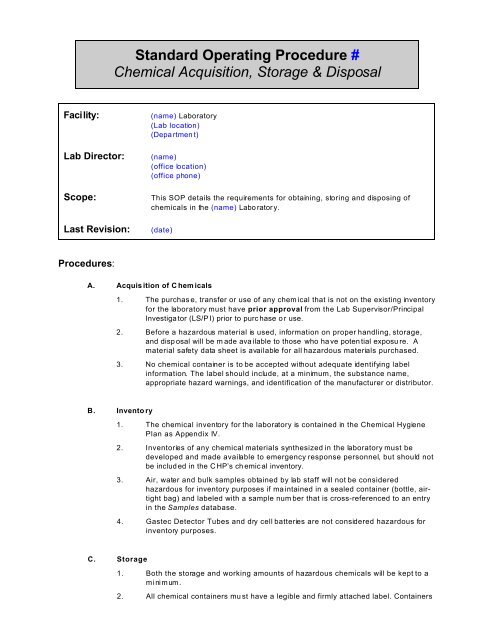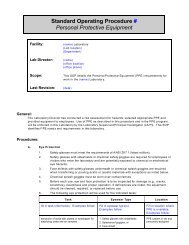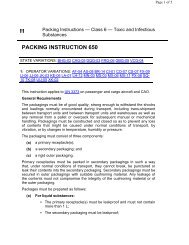Standard Operating Procedure # Chemical Acquisition, Storage ...
Standard Operating Procedure # Chemical Acquisition, Storage ...
Standard Operating Procedure # Chemical Acquisition, Storage ...
Create successful ePaper yourself
Turn your PDF publications into a flip-book with our unique Google optimized e-Paper software.
<strong>Standard</strong> <strong>Operating</strong> <strong>Procedure</strong> #<br />
<strong>Chemical</strong> <strong>Acquisition</strong>, <strong>Storage</strong> & Disposal<br />
Facility:<br />
Lab Director:<br />
Scope:<br />
Last Revision:<br />
(name) Laboratory<br />
(Lab location)<br />
(Departmen t)<br />
(name)<br />
(office location)<br />
(office phone)<br />
This SOP details the requirements for obtaining, storing and disposing of<br />
chemicals in the (name) Labo ratory.<br />
(date)<br />
<strong>Procedure</strong>s:<br />
A. <strong>Acquisition</strong> of C hemicals<br />
1. The purchase, transfer or use of any chemical that is not on the existing inventory<br />
for the laboratory must have prior approval from the Lab Supervisor/Principal<br />
Investigator (LS/PI) prior to purc hase or use.<br />
2. Before a hazardous material is used, information on proper handling, storage,<br />
and disp osal will be m ade ava ilable to those who have potential exposu re. A<br />
material safety data sheet is available for all hazardous materials purchased.<br />
3. No chemical container is to be accepted without adequate identifying label<br />
information. The label should include, at a minimum, the substance name,<br />
appropriate hazard warnings, and identification of the manufacturer or distributor.<br />
B. Inventory<br />
1. The chemical inventory for the laboratory is contained in the <strong>Chemical</strong> Hygiene<br />
Plan as Appendix IV.<br />
2. Inventories of any chemical materials synthesized in the laboratory must be<br />
developed and made available to emergency response personnel, but should not<br />
be included in the C HP’s ch emical inventory.<br />
3. Air, water and bulk samples obtained by lab staff will not be considered<br />
hazardous for inventory purposes if maintained in a sealed container (bottle, airtight<br />
bag) and labeled with a sample num ber that is cross-referenced to an entry<br />
in the Samples database.<br />
4. Gastec Detector Tubes and dry cell batteries are not considered hazardous for<br />
inventory purposes.<br />
C. <strong>Storage</strong><br />
1. Both the storage and working amounts of hazardous chemicals will be kept to a<br />
minimum.<br />
2. All chemical containers must have a legible and firmly attached label. Containers
<strong>Chemical</strong> SOP #<br />
Page 2<br />
of peroxidizable chemicals (dioxane, THF, ethyl ether, etc.) will be dated when<br />
received and also when opened.<br />
3. <strong>Chemical</strong>s shall be stored in compatible containers which will be kept closed<br />
when not in use.<br />
4. Periodic inventories will be conducted by the LS/PI and unneeded items will be<br />
identified/disc arded, returned to storage or proce ssed fo r hazardo us was te<br />
disposal.<br />
5. <strong>Storage</strong> of flammable/combustible liquids in excess of 10 gallons must be in an<br />
approved flam ma ble m ateria ls cab inet. Lab pe rson nel ar e to notify the LS/P I is<br />
flammable/combustible volume exceeds 10 gallons.<br />
6. The lab refrigerator is not an acceptable storage location for flammable or<br />
combustible liquids. Refrigerators/freezers used for flammable chemical storage<br />
must be specifically approved for such use.<br />
7. Compressed gas cylinders must be secured at all times with the straps attached<br />
to the bench. The LS/PI is the only person authorized to connect, disconnect, or<br />
transpo rt gas cylinders for the IA Q Mo nitor Tes t Bench..<br />
8. Incom patible che micals mus t be segregated by class. (Identify storage strategy<br />
and storage locations. Example:<br />
Flammab le Solvents :<br />
Alcohols, ketones and alkanes will be stored in flammables cabinet #1.<br />
Alkenes, ethers and aromatics will be stored in flammables cabinet #2.<br />
Mineral acids will be stored in the corrosives storage cabinet beneath the<br />
chemical fume hood.<br />
Oxidizers will be stored in the corrosives cabinet next to the fume hood.<br />
Misc ellane ous salts will be s tored on the she lves a long the west w all in<br />
alphabetical order.<br />
D. Disposal<br />
1. Each person working in the laboratory has a responsibility to see that wastes are<br />
properly packaged and disposed.<br />
2. All lab staff processing chemicals for waste disposal must receive annual training<br />
coordinated by DES - Environmental Affairs.<br />
3. The laboratory's routine waste streams are as follows:<br />
a. nickel-cadmium & metal hydride batteries<br />
b. expired calibration gases<br />
4. The sanitary drain will not be used for disposal of chemicals unless prior<br />
approval is obtained from the lab director.<br />
5. Broken glassware will be placed in a rigid cardboard box which will be taped<br />
closed and placed directly in the building’s dumpster.
















